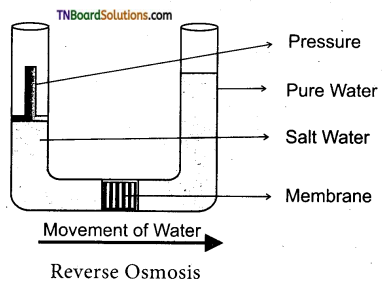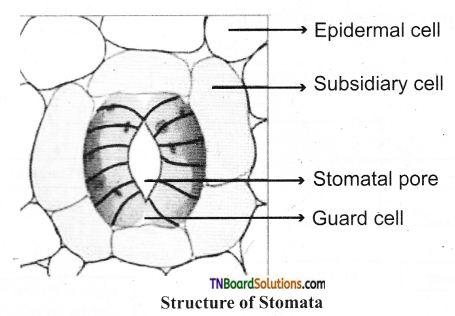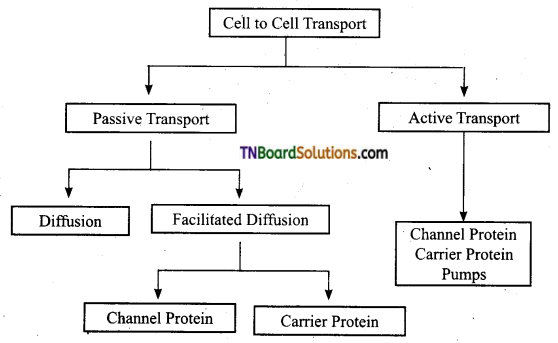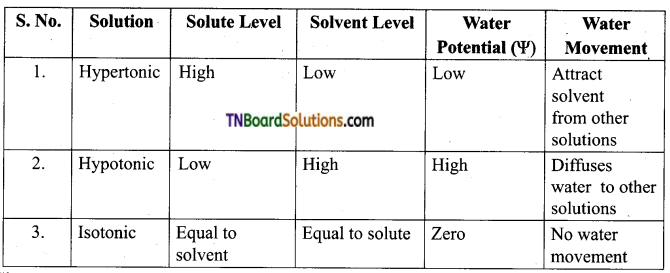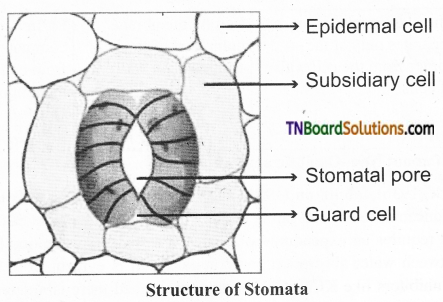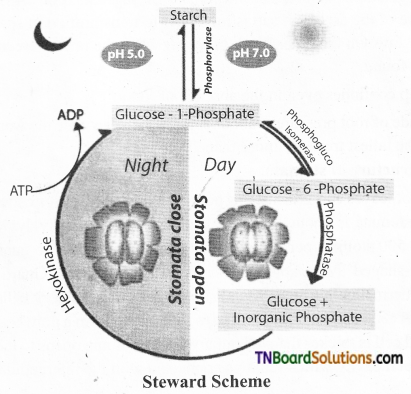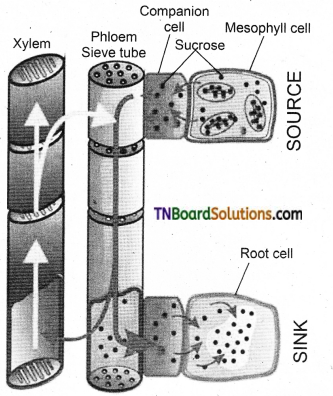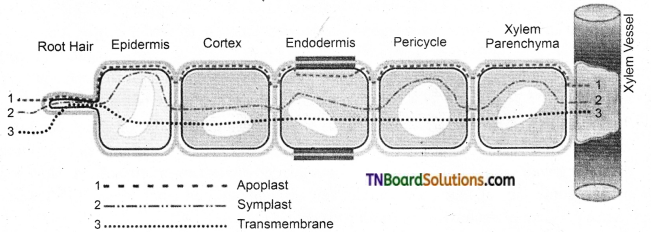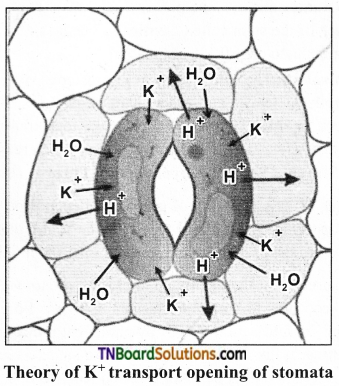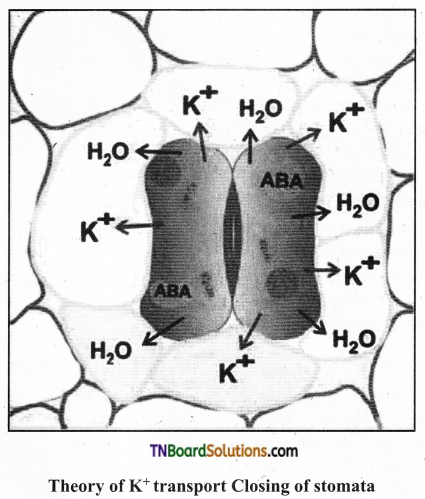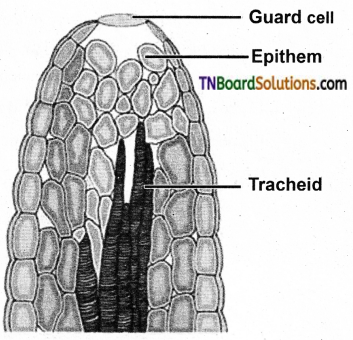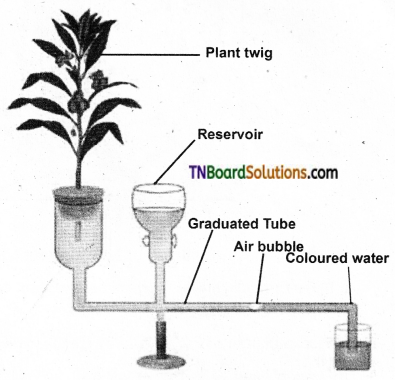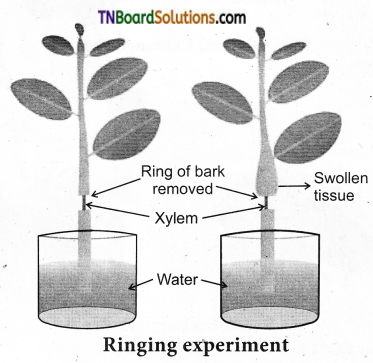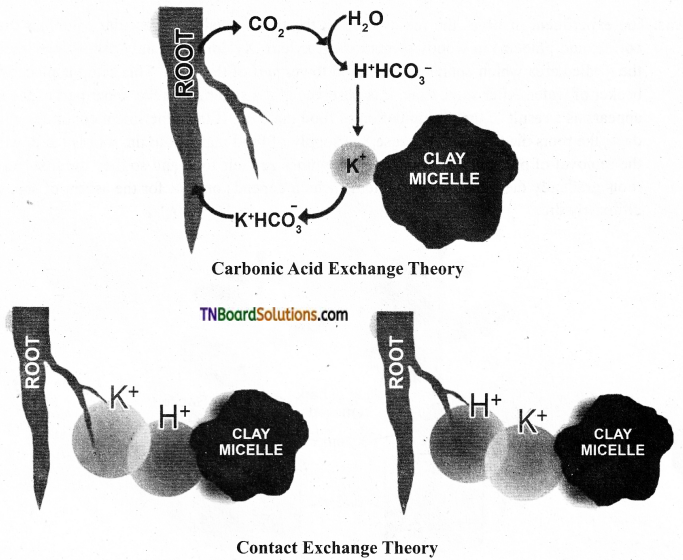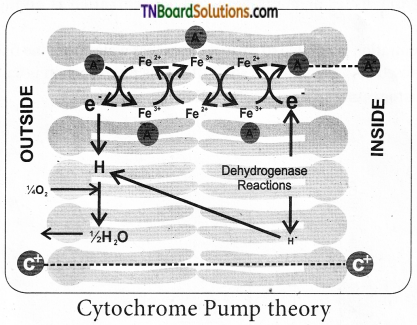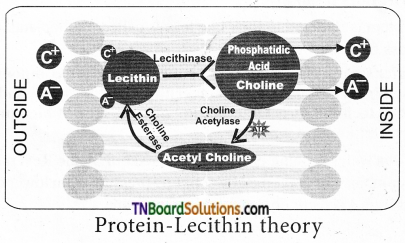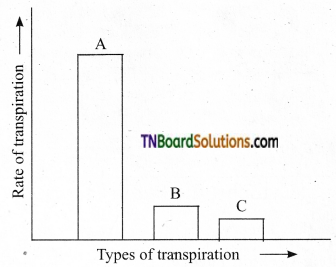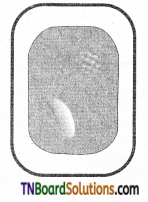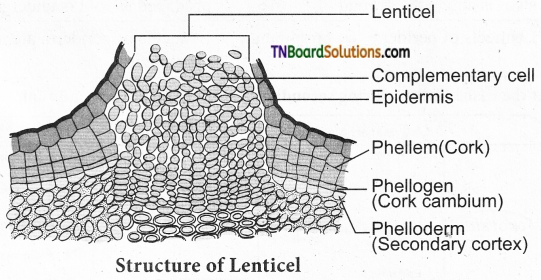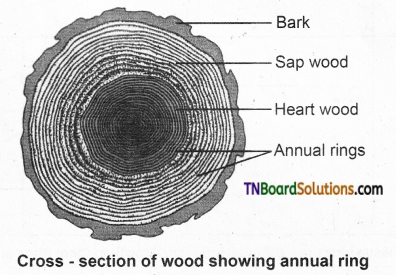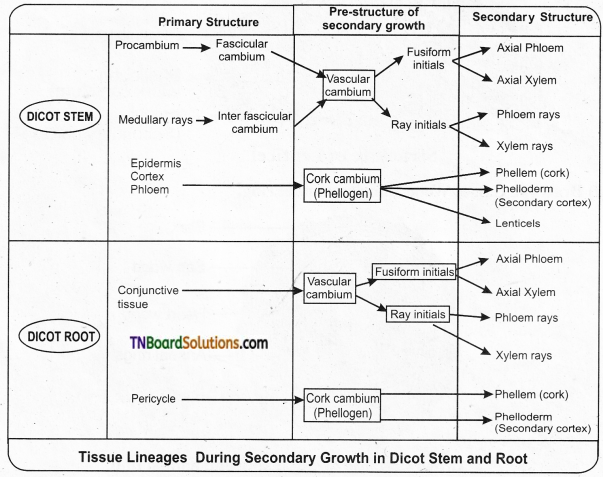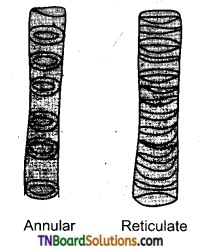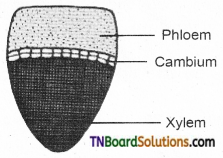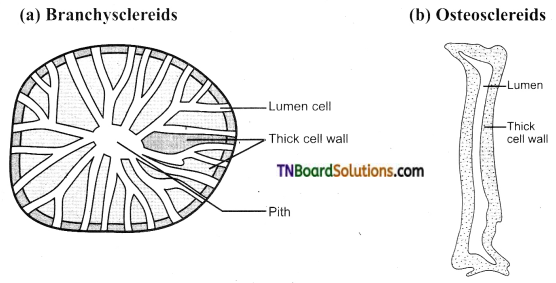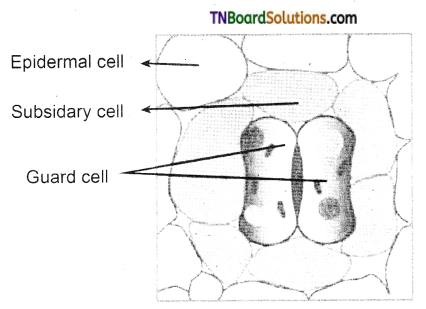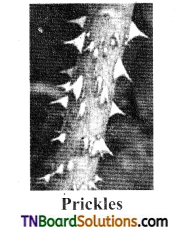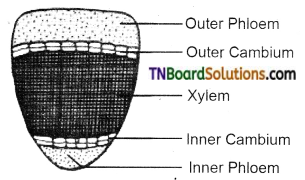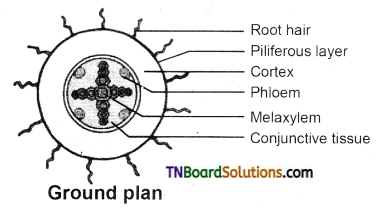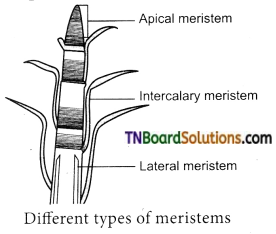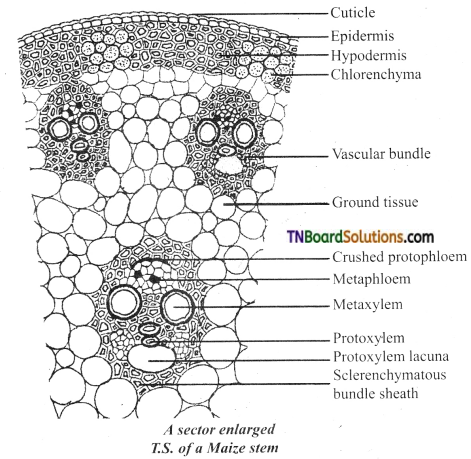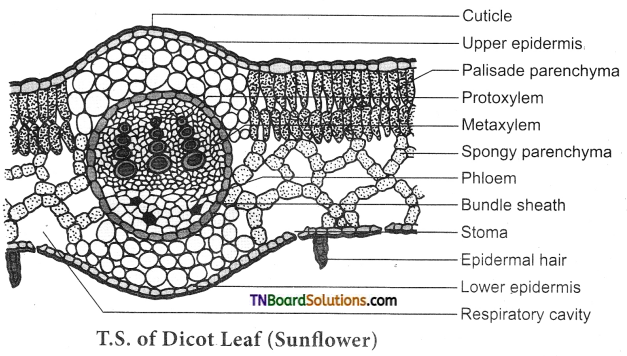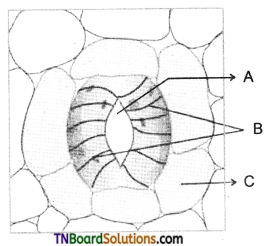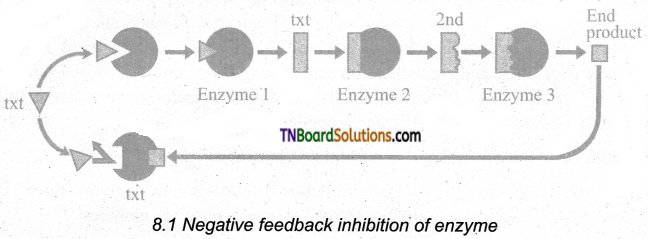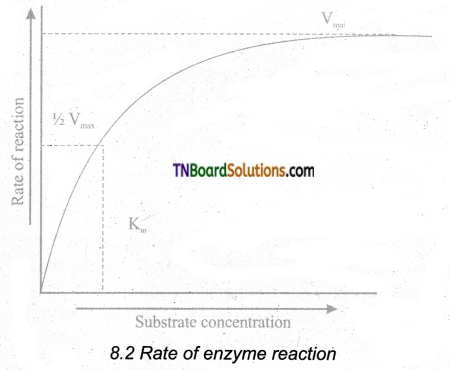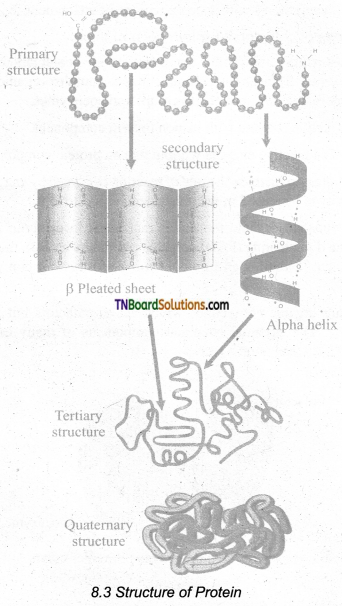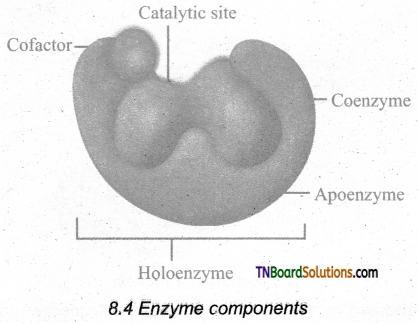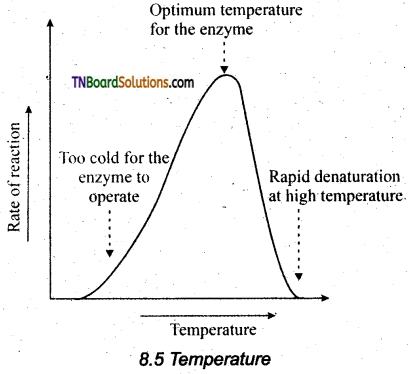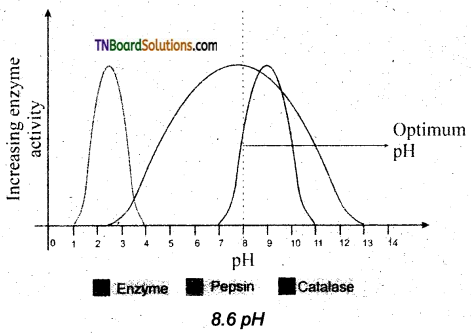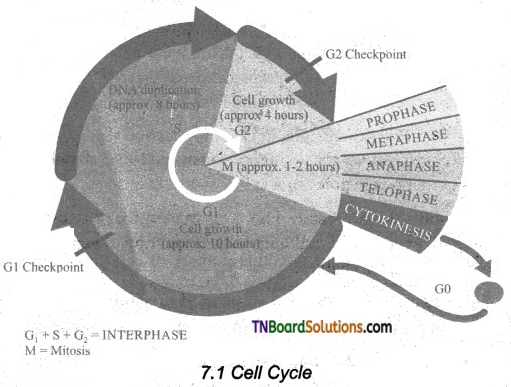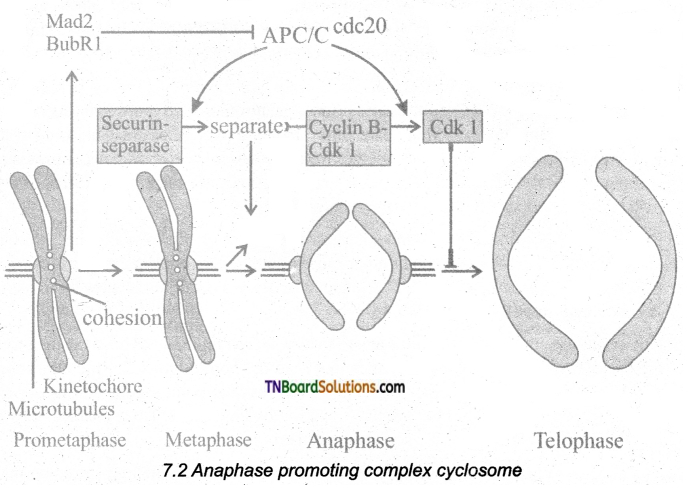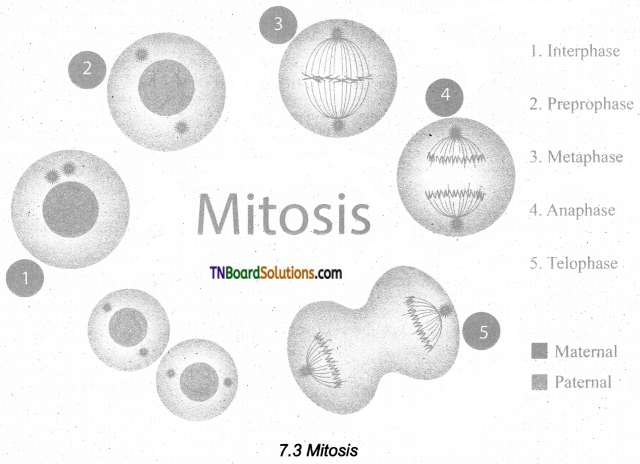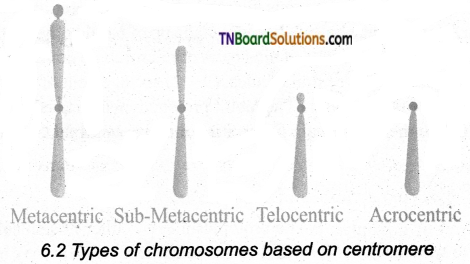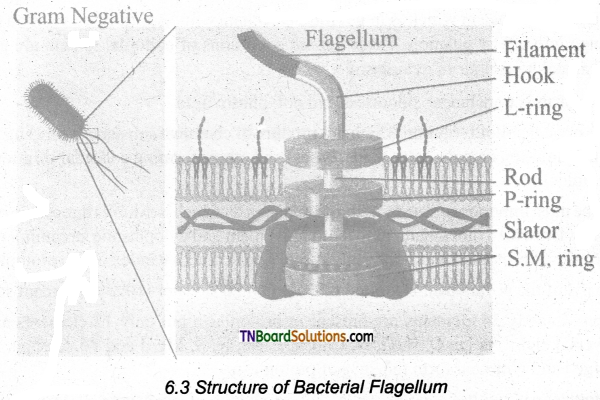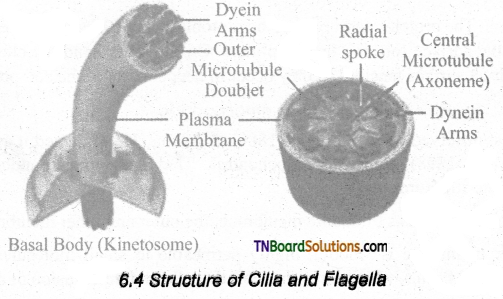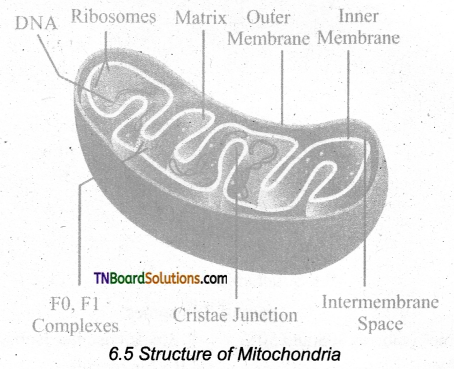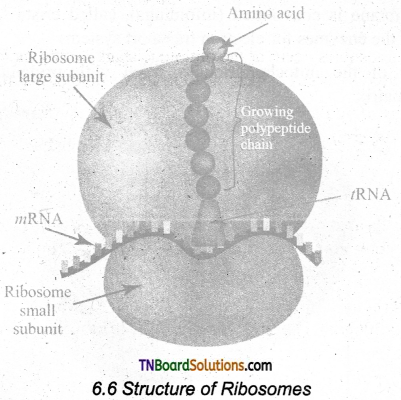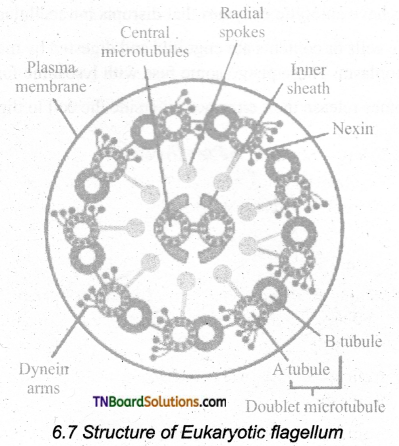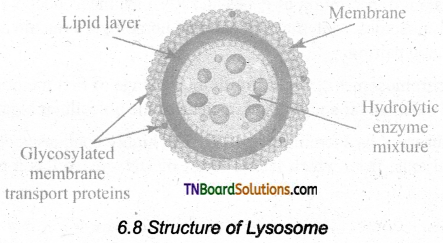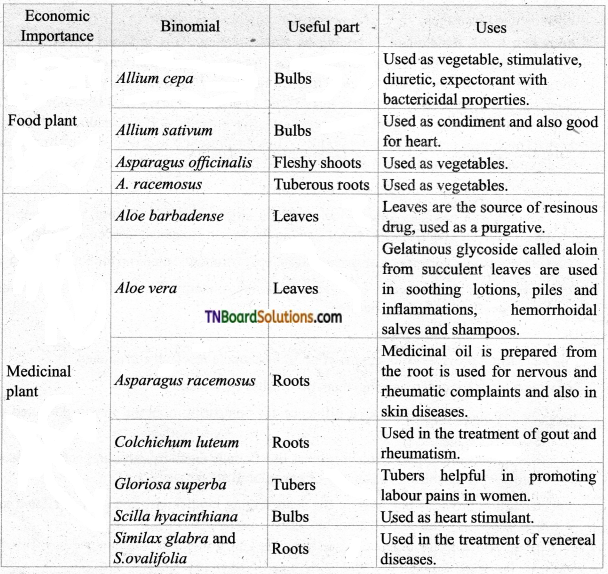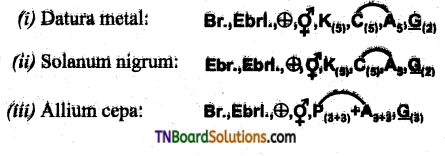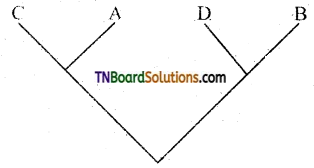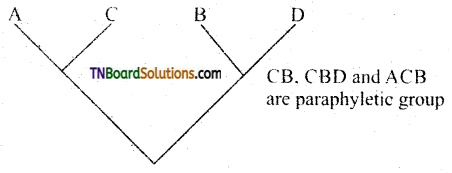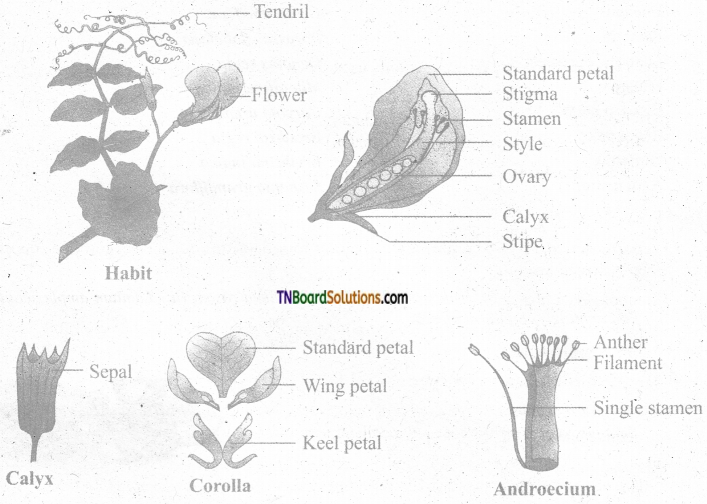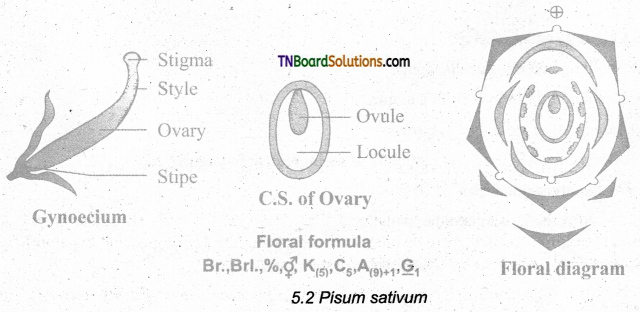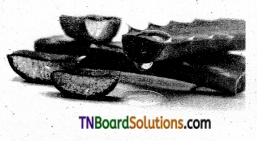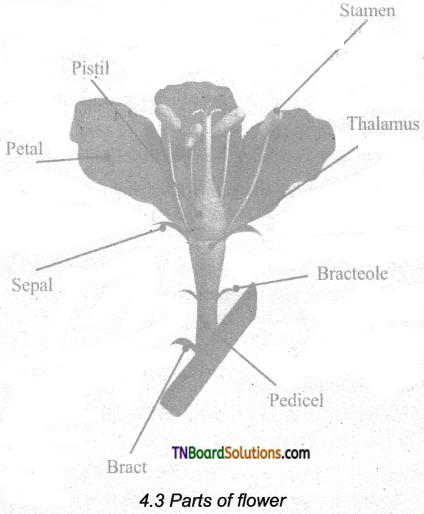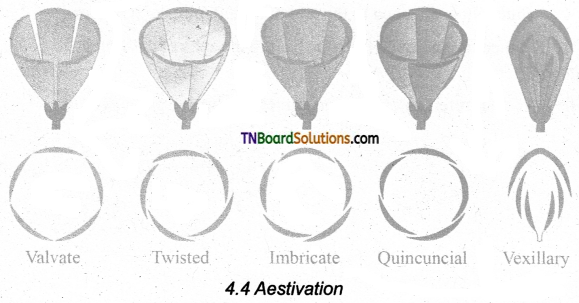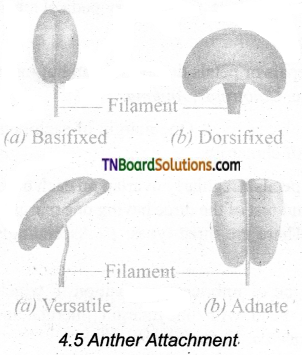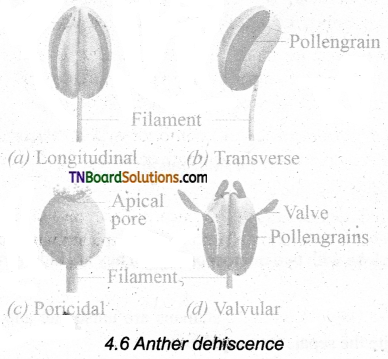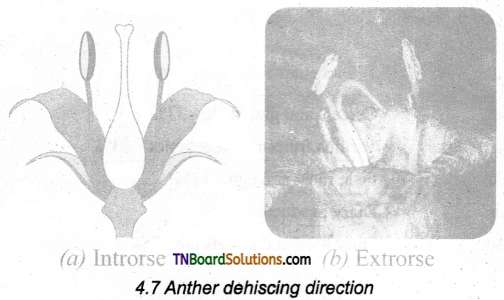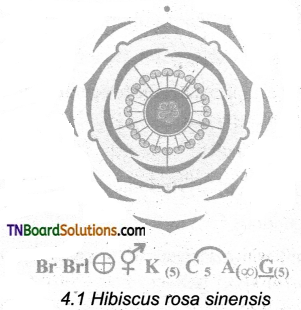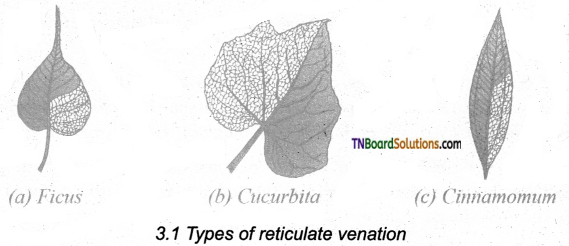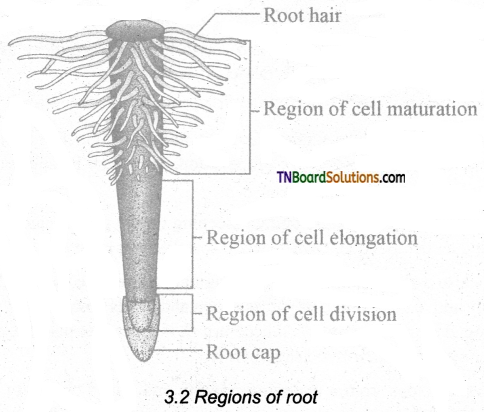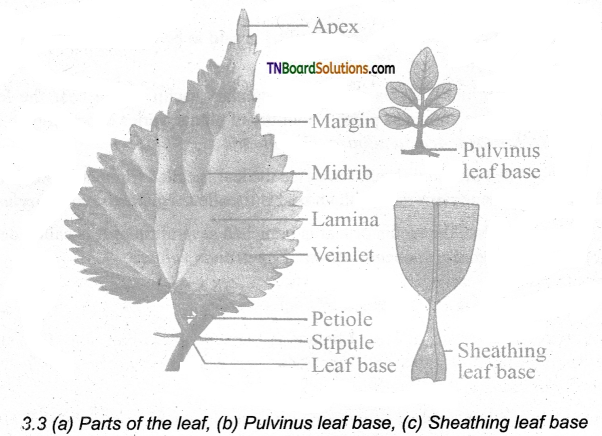Students get through the TN Board 11th Bio Botany Important Questions Chapter 12 Mineral Nutrition which is useful for their exam preparation.
TN State Board 11th Bio Botany Important Questions Chapter 12 Mineral Nutrition
Very short answer questions
Question 1.
Differentiate between Micronutrient and Macronutrient.
Answer:
| Micronutrient | Macronutrient |
| Micronutrients are the essential minerals required in less concentrations. Example: Copper | Macronutrients are the essential minerals required in higher concentrations. Example: Nitrogen |
Question 2.
State the “Law of minimum” proposed by Liebig.
Answer:
The “law of minimum” states that the productivity of soil depends on the number of essential elements present in minimum quantity.
Question 3.
Mention any four unclassified minerals.
Answer:
Sodium, Cobalt, Silicon and Selenium.
![]()
Question 4.
Potassium and Osmotic potential – Comment.
Answer:
Potassium (K) plays a key role in maintaining the osmotic potential of the cell. The absorption of water, movement of stomata and turgidity are due to osmotic potential.
Question 5.
In which form do the following minerals are absorbed by plants.
(a) Nitrogen
(b) Magnesium
(c) Boron
(d) Phosphorous
Answer:
| S. No. | Minerals | Absorbable Forms |
| a. | Nitrogen | Nitrates (NO3) |
| b. | Magnesium | Mg2+ |
| c. | Boron | Borate (BO3–) |
| d. | Phosphorous | H2PO4+/HPO4– |
Question 6.
Name any two calcium deficiency disease in plants.
Answer:
(a) Blackheart of celery,
(b) Hooked leaf tip in beet, Musa and tomato.
Question 7.
Nitrogen is a Macronutrient – Justify.
Answer:
Nitrogen (N) is required by the plants in the greatest amount. It is an essential component of proteins, nucleic acids, amino acids, vitamins, hormones, alkaloids, chlorophyll and cytochrome.
![]()
Question 8.
What are Siderophores?
Answer: Siderophores (iron carriers) are Iron chelating agents produced by bacteria. They are used to chelate ferric iron (Fe3+) from the environment and host.
Question 9.
Given below are the plant diseases, name the deficient mineral responsible for the disease.
(a) Khaira disease
(b) Internal cork of apple
(c) Die back of Citrus
(d) Sand drown of tobacco
Answer:
| Plant Diseases | Deficient Mineral |
| Khaira disease of rice | Zinc |
| Internal cork of apple | Boron |
| Dieback of Citrus | Copper |
| Sand drown of tobacco | Magnesium |
Question 10.
Define Calmodulin.
Answer:
Calmodulin is a Ca2+ modulating protein in eukaryotic cells. It is a heat-stable protein involved in fine metabolic regulations.
Question 11.
When does an essential mineral is considered “toxic”?
Answer:
An increase of mineral nutrients more than the normal concentration causes toxicity. A concentration, at which 10 % of the dry weight of tissue is reduced, is considered toxic.
![]()
Question 12.
Give a brief note on Aluminium toxicity.
Answer:
Aluminium toxicity causes precipitation of nucleic acid, inhibition of ATPase, inhibition of cell division and binding of the plasma membrane with Calmodulin.
Question 13.
Define nitrogen fixation. Mention its types.
Answer:
The process of converting atmospheric nitrogen (N2) into ammonia is termed as nitrogen fixation. Nitrogen fixation can occur by two methods: 1. Biological; 2. Non-Biological.
Question 14.
How does nitrogen fixation occur non-biologically?
Answer:
Non – Biological nitrogen fixation:
- Nitrogen fixation by a chemical process in the industry.
- Natural electrical discharge during lightning fixes atmospheric nitrogen.
Question 15.
Name the types of Autotrophic nutrition.
Answer:
(a) Photosynthetic autotrophs and (b) Chemosynthetic autotrophs.
Question 16.
What are obligate parasites? Give example.
Answer:
Obligate (Total) parasites completely depend on the host for survival. Example: Cuscuta.
![]()
Question 17.
What is a Lichen?
Answer:
Lichens is a mutual association of Algae and Fungi. Algae prepare food and fungi absorbs water and provides thallus structure.
Short answer questions
Question 1.
List out the criteria for being essential minerals.
Answer:
Arnon and Stout (1939) gave criteria required for essential minerals:
- Elements are necessary for growth and development.
- They should have a direct role in the metabolism of the plant.
- It cannot be replaced by other elements.
- Deficiency makes the plants impossible to complete their vegetative and reproductive phase.
Question 2.
Mention the role of Sulphur in plants.
Answer:
Sulphur (S): Essential component of amino acids like cystine, cysteine and methionine, a constituent of coenzyme A, Vitamins like biotin and thiamine, a constituent of proteins and ferredoxin. Plants utilise sulphur as sulphate (SO4–) ions.
Deficiency symptoms: Chlorosis, anthocyanin formation, stunted growth, rolling of leaf tip and reduced nodulation in legumes.
Question 3.
Give a short note on EDTA.
Answer:
EDTA – Ethylene Diamine Tetra Acetic acid is a chelating agent.
Plants growing in alkaline soil though supplied with all nutrients including iron show iron deficiency. To rectify this, iron is made into a soluble complex by adding EDTA (Fe-EDTA Complex) which can be easily absorbed by plants.
![]()
Question 4.
Write a brief note on Manganese toxicity.
Answer:
Increased Concentration of Manganese will prevent the uptake of Fe and Mg, prevent translocation of Ca to the shoot apex and cause their deficiency. The symptoms of manganese toxicity are the appearance of brown spots surrounded by chlorotic veins.
Question 5.
Write a note on Hydroponics and Aeroponics.
Answer:
Hydroponics or Soilless culture: Von Sachs developed a method of growing plants in the nutrient solution. The commonly used nutrient solutions are Knop solution (1865) and Arnon and Hoagland Solution (1940). Later the term Hydroponics was coined by Goerick (1940) and he also introduced commercial techniques for hydroponics. In hydroponics roots are immersed in the solution containing nutrients and air is supplied with help of a tube.
Aeroponics: This technique was developed by Soifer Hillel and David Durger. It is a system where roots are suspended in air and nutrients are sprayed over the roots by a motor-driven rotor.
Question 6.
Mention the three possible ways by which ammonia is converted into amino acids during nitrogen metabolism.
Answer:
Ammonia is converted into amino acids by the following processes:
(a) Reductive amination, (b) Trans-amination and (c) Catalytic amination.
Question 7.
Write the equation for reductive amination.
Answer:

![]()
Question 8.
Transamination – Write a note.
Answer:
Transfer of amino group (NH3+) from glutamic acid glutamate to keto group of a keto acid. Glutamic acid is the main amino acid from which other amino acids are synthesised by transamination. Transamination requires the enzyme transaminase and coenzyme pyridoxal phosphate (derivative of vitamin B6 – pyridoxine).
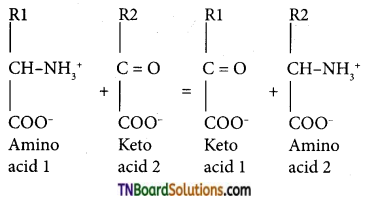
Question 9.
Give an account on GOGAT – pathway.
Answer:
Glutamate amino acid combines with ammonia to form the amide glutamine.

Glutamine reacts with α ketoglutaric acid to form two molecules of glutamate.

Question 10.
Write a note on Saprophytes.
Answer:
Saprophytes derive nutrients from dead and decaying matter. Bacteria and fungus are the main saprophytic organisms. Some angiosperms also follow the saprophytic mode of nutrition. Example: Neottia. Roots of Neottia (Bird’s Nest Orchid) associate with mycorrhizae and absorb nutrients as a saprophyte. Monotropa (Indian Pipe) grow on humus-rich soil found in thick forests. It absorbs nutrient through mycorrhizal association.
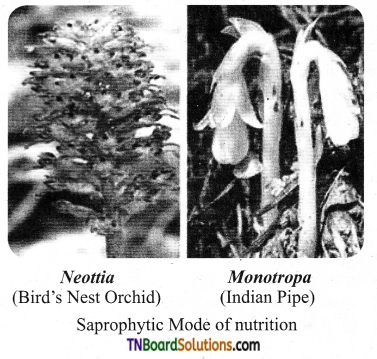
Question 11.
What is Mycorrhizae?
Answer:
Mycorrhizae: Fungi associated with roots of higher plants including Gymnosperms. Example: Pinus.
![]()
Long answer questions
Question 1.
Write in detail about functions, mode of absorption and deficiency symptoms of any five macronutrients.
Answer:
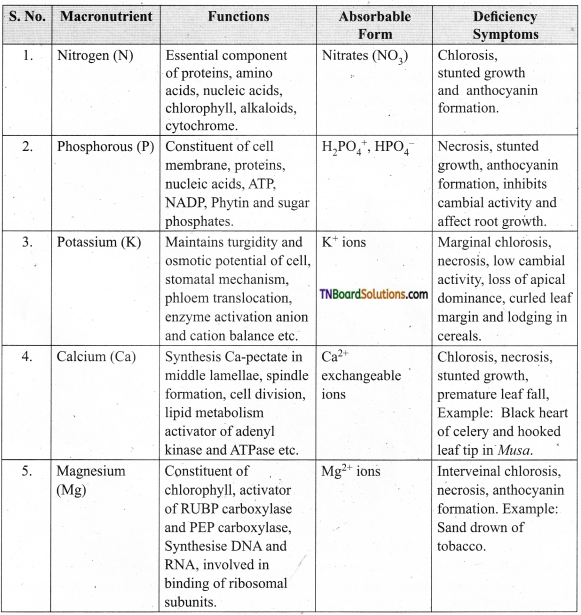
Question 2.
Give in detail about the vitality of Boron and Zinc in plant nourishment.
Answer:
Zinc (Zn): Essential for the synthesis of Indole acetic acid (Auxin) activator of carboxylases, alcohol dehydrogenase, lactic dehydrogenase, glutamic acid dehydrogenase, carboxypeptidases and tryptophan synthetase. It is absorbed as Zn2+ ions.
Deficiency: Little leaf and mottle leaf due to deficiency of auxin, Inter veinal chlorosis, stunted growth, necrosis and Khaira disease of rice.
Boron (B): Translocation of carbohydrates, uptake and utilisation of Ca++, pollen germination, nitrogen metabolism, fat metabolism, cell elongation and differentiation. It is absorbed as borate BO3- ions.
Deficiency: Death of root and shoot tips, premature fall of flowers and fruits, the brown heart of beet root, the internal cork of apple and fruit cracks.
![]()
Question 3.
Explain in detail the symbiotic nitrogen fixation with nodulation.
Answer:
i. Nitrogen fixation with nodulation:
Rhizobium bacterium is found in leguminous plants and fixes atmospheric nitrogen. This kind of symbiotic association is beneficial for both the bacterium and the plant. Root nodules are formed due to bacterial infection. Rhizobium enters into the host cell and proliferates, it remains separated from the host cytoplasm by a membrane.
Stages of Root nodule formation:
- Legume plants secret phenolics which attracts Rhizobium.
- Rhizobium reaches the rhizosphere and enters into the root hair, infects the root hair and leads to curling of root hairs.
- The infection thread grows inwards and separates the infected tissue from normal tissue.
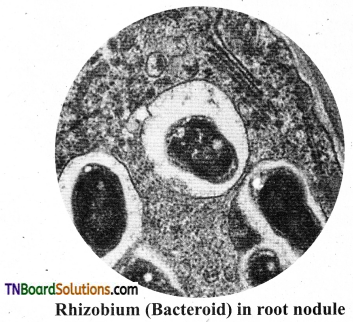
- A membrane bound bacterium is formed inside the nodule and is called a bacteroid.
- Cytokinin from bacteria and auxin from host plant promotes cell division and leads to nodule formation.
Question 4.
Describe the various stages of the nitrogen cycle.
Answer:
The nitrogen cycle consists of the following stages:
1. Fixation of atmospheric nitrogen: Di-nitrogen molecule from the atmosphere progressively gets reduced by the addition of a pair of hydrogen atoms. A triple bond between two nitrogen atoms (N = N) is cleaved to produce ammonia. The nitrogen fixation process requires a Nitrogenase enzyme complex, Minerals (Mo, Fe and S), anaerobic condition, ATP, electron and glucose 6 phosphates as H+ donor. The nitrogenase enzyme is active only in anaerobic condition. To create this anaerobic condition a pigment known as leghaemoglobin is synthesized in the nodules which act as an oxygen scavenger and removes the oxygen. Nitrogen-fixing bacteria in root nodules appear pinkish due to the presence of this leghaemoglobin pigment.
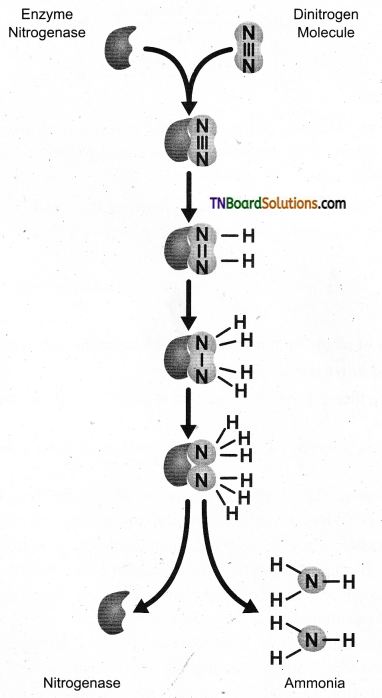
Overall equation:
N2 + 8e– + 8H+ + 16 ATP → 2NH3+ + H2 + 16 ADP + 16 Pi
2. Nitrification: Ammonia (NH3+) is converted into Nitrite (NO2–) by Nitrosomonas
bacterium. Nitrite is then converted into Nitrate (NO3–) by Nitrobacter bacterium. Plants are more adapted to absorb nitrate (NO3–) than ammonium ions from the soil.

3. Nitrate Assimilation: The process by which nitrate is reduced to ammonia is called nitrate assimilation and occurs during the nitrogen cycle.
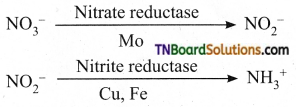
4. Ammonification: The decomposition of organic nitrogen (proteins and amino acids) from dead plants and animals into ammonia is called ammonification. Organism involved in this process are Bacillus ramosus and Bacillus Vulgaris.
5. Denitrification: Nitrates in the soil are converted back into atmospheric nitrogen by a process called denitrification. Bacteria involved in this process are Pseudomonas, Thiobacillus and Bacillus subtilis.

![]()
Question 5.
Explain the types of parasitic mode of nutrition in angiosperms.
Answer:
Parasitic mode of nutrition in angiosperms:
Organisms deriving their nutrient from another organism (host) and causing the disease to the host are called parasites.
a. Obligate or Total parasite – Completely depends on the host for their survival and produces haustoria.
- Total stem parasite: The leafless stem twine around the host and produce haustoria. Example: Cuscuta (Dodder), a rootless plant growing on Zizyphus, Citrus and so on.
- Total root parasite: They do not have stem axis and grow in the roots of host plants to produce haustoria. Example: Rafflesia, Orobanche and Balanophora.
b. Partial parasite – Plants of this group contain chlorophyll and synthesize carbohydrates. Water and mineral requirements are dependent on a host plant.
- Partial Stem Parasite: Example: Loranthus and Viscum (Mistletoe) Loranthus grows on fig and mango trees and absorb water and minerals from the xylem.
- Partial root parasite: Example: Santalum album (Sandalwood tree) in its juvenile stage produces haustoria which grow on roots of many plants.
Higher Order Thinking Skills (HOTs)
Question 1.
In metro cities like Chennai, there is a lack of space for a garden. Suggest a technique by which plants can be grown without the need for soil and land space.
Answer:
The technique which can be used is hydroponics in which nutrient solution is used for growing plants.
Question 2.
Carnivorous plants like Nepenthes and venus fly trap have nutritional adaptation. Which nutrient do they especially obtain and from where?
Answer:
Plants like nepenthes and venus fly trap etc. are found grouping in nitrogen-deficient soil. To compensate, their body parts are modified to trap insects from which they obtain sufficient nitrogen for their survival. Hence, they are carnivorous in nature.
Question 3.
Excess of manganese in the soil leads to deficiency of Mg, Fe and Ca. Justify.
Answer:
Increased concentration of Manganese will prevent the uptake of Fe and Mg and prevent translocation of Ca to the shoot apex and cause their deficiency. This condition is referred to as manganese toxicity.
![]()
Question 4.
Name the crucial enzyme found in the root nodules of leguminous plants for nitrogen fixation. Also, name the pigment which is highly essential for the activation of the enzyme.
Answer:
Root nodules of legume plants contained nitrogenase enzyme for nitrogen fixation.
Leghaemoglobin is the pink coloured pigment that creates an anaerobic condition for the activation of the nitrogenase complex.
Question 5.
Plants require nutrients. If we supply these in excess will they be beneficial to plants? If yes, how? If no, why?
Answer:
No, an excess supply of nutrients is not advised for the healthier growth of plants. Due to the fact that increased concentration of nutrients may lead to the toxicity of particular minerals which prevents the uptake of other minerals and also affect various other metabolic activities of the cells, leading to the poor growth of the plant.
Question 6.
X is a primitive, eukaryotic chlorophyllous organism and Y is a eukaryotic, achlorophyllous organism. Both X and Y live mutually together benefitting each other.
(a) Name this mutual association.
(b) What X and Y are?
(c) Explain their relationship?
Answer:
(a) Lichens.
(b) X = Algae, Y = fungi
(c) In lichens, Algae prepare food and fungi absorbs water and provides thallus structure.
Choose the correct answer.
1. Identify the micronutrient.
(a) Potassium
(b) Phosphorous
(c) Manganese
(d) Magnesium
Answer:
(c) Manganese
2. Which mineral is essential for cell wall formation in Equisetuml?
(a) Boron
(b) Silicon
(c) Cellulose
(d) Carbon
Answer:
(b) Silicon
![]()
3. ‘Law of Minimum’ was proposed by ……………
(a) Van Helmont
(b) Von Sachs
(c) Wood word
(d) Liebig
Answer:
(d) Liebig
4. Identify the wrong statement(s).
(i) Molybdenum is a micronutrient.
(ii) Carbon, Hydrogen, Nitrogen are skeletal elements.
(iii) Manganese is the activator for RUBP carboxylase.
(iv) Potassium maintains osmotic potential of the cell.
(a) (i) and (iv)
(b) (ii) and (iii)
(c) Only (ii)
(d) Only (iv)
Answer:
(b) (ii) and (iii)
5. Siderophores are ……….. chelators.
(a) B
(b) Fe3+
(c) Ca2+
(d) Cl–
Answer:
(b) Fe3+
6. Match the following:
(i) Boron 1. Nitrogen metabolism
(ii) Molybdenum 2. Formation of Porphyrin
(iii) Zinc 3. Translocation of sugars
(iv) Iron 4. Biosynthesis of auxin
(a) (i) – 3, (ii) – 1, (iii) – 4, (iv) – 2
(b) (i) – 2, (ii) – 3, (iii) – 4, (iv) – 1
(c) (i) – 3, (ii) – 4, (iii) – 2, (iv) – 1
(d) (i) – 4, (ii) – 1, (iii) – 2, (iv) – 3
Answer:
(a) (i) – 3, (ii) – 1, (iii) – 4, (iv) – 2
7. Exanthema in Citrus is due to ………… deficiency.
(a) Mo
(b) Cu
(c) B
(d) Zn
Answer:
(b) Cu
8. Mottle leaf disease is a ………… deficiency disease.
(a) Gibberellins
(b) Cytokinin
(c) Auxin
(d) Ethylene
Answer:
(c) Auxin
![]()
9. Pollen germination requires ………… mineral.
(a) Copper
(b) Molybdenum
(c) Chlorine
(d) Boron
Answer:
(d) Boron
10. ………… toxicity leads to precipitation of nucleic acids.
(a) Manganese
(b) Iron
(c) Aluminium
(d) Boron
Answer:
(c) Aluminium
11. The term soilless culture refers to …………
(a) Aeroponics
(b) Aquaculture
(c) Hydroponics
(d) Drip irrigation
Answer:
(c) Hydroponics
12. The term hydroponics was coined by …………..
(a) Amon
(b) David Durger
(c) Liebig
(d) Goerick
Answer:
(d) Goerick
13. Which of the following is a free-living bacterium?
(a) Rhizobium
(b) Clostridium
(c) Escherichia
(d) Cyanobacteria
Answer:
(b) Clostridium
![]()
14. Legume plants secrete………… which attracts Rhizobium.
(a) Toluenes
(b) Phenolics
(c) Octanes
(d) Xylenes
Answer:
(b) Phenolics
15. In N2, how many bonds are there between two nitrogen atoms?
(a) Two
(b) Four
(c) Three
(d) One
Answer:
(c) Three
16. Leghaemoglobin pigments removes ……….. to activate nitrogenase enzyme.
(a) CO
(b) CO2
(c) O
(d) N
Answer:
(c) O
17. Which bacterium is NOT involved in Denitrification?
(a) Pseudomonas
(b) Thiobacillus
(c) Bacillus subtilis
(d) Nitrobacter
Answer:
(d) Nitrobacter
18. On reaction with a-ketoglutaric acid, ammonia yields ………….
(a) Glutamate
(b) Malate
(c) Glutamine
(d) Oxoglutarate
Answer:
(a) Glutamate
![]()
19. Pyridoxal phosphate is a derivative of vitamin ……………
(a) A
(b) B12
(c) B6
(d) D
Answer:
(c) B6
20. Identify the correct pair:
(i) Cuscuta – Stem parasite
(ii) Viscum – Total parasite
(Hi) Dionaea – Saprophyte
(iv) Lichen – Fungi and bacteria
(a) (i) only
(b) (ii) only
(c) Both (i) and (ii)
(d) Both (iii) and (iv)
Answer:
(a) (i) only
21. Assertion: Loranthus is a partial parasite.
Reason: Partial parasite depends on the host for water & minerals only.
(a) A is right, R is wrong
(b) Both A and R are correct
(c) A is right R, explains A
(d) A is the wrong R, explains A
Answer:
(c) A is right R, explain A
22. Pitcher plant is the common name for …………
(a) Drosera
(b) Nepenthes
(c) Utricularia
(d) Dionaea
Answer:
(b) Nepenthes
![]()
23. Insectivorous plants are usually seen in ………… deficient soil.
(a) Sulphur
(b) Nitrogen
(c) Carbon
(d) Potassium
Answer:
(b) Nitrogen
24. ………… is a pioneer species in xeric succession.
(a) Lichens
(b) Mycorrhizae
(c) Cyanobacteria
(d) Pteridophyte
Answer:
(a) Lichens
